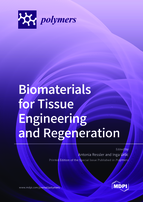Biomaterials for Tissue Engineering and Regeneration
A special issue of Polymers (ISSN 2073-4360). This special issue belongs to the section "Biomacromolecules, Biobased and Biodegradable Polymers".
Deadline for manuscript submissions: closed (30 December 2022) | Viewed by 55551
Special Issue Editors
Interests: biodegradable polymers; biomaterials; chitosan; hydroxyapatite; scaffolds; ionic substitution; stem cells; tissue engineering and regeneration
Special Issues, Collections and Topics in MDPI journals
Interests: cancer biology; stem cells; drug delivery; scaffolds; tissue engineering
Special Issues, Collections and Topics in MDPI journals
Special Issue Information
Dear Colleagues,
Biomaterials serve as an integral component of tissue engineering and their development is crucial for the further progress of new and efficient approaches in the regenerative medicine of bone, cartilage, tendons and ligaments, skin, soft tissue wounds, cardiac muscle, vascular tissues, and neural tissues. Polymer-based biomaterials are extensively studied in the field of tissue engineering due to their biocompatible and biodegradable properties. This Special Issue, entitled Biomaterials for Tissue Engineering and Regeneration, is devoted to recent advances in the development of synthetic and/or natural biomaterial scaffolds, hydrogels, polypeptides, polymer-based composites, and composites based on polymers and inorganic materials such as bioactive ceramics and glasses. New technologies (e.g., bioprinting, additive manufacturing) for forming biomaterials for tissue engineering of three-dimensional (3D) constructs are of great interest.
The scope of this Special Issue includes, but is not limited to, the following topics:
- 3D polymer-based scaffolds;
- Structure–property relationships of polymeric and composite biomaterials;
- In vitro and in vivo biodegradability, biocompatibility, anticancer, and antibacterial properties;
- Polymers for tissue engineering and regeneration;
- Stem cell engineering;
- Drug delivery (e.g., solid lipid nanoparticles, hydrogels);
- New technologies for scaffold formation (3D fabrication).
Improvements in the field of tissue regeneration relies on bringing together experts from different fields, such as materials science, polymer science, mechanical engineering, biomaterials, cell biology, nanotechnology, immunology, etc. For this Special Issue, we invite scientists from different fields to contribute with recent original research and review articles.
Dr. Antonia Ressler
Dr. Inga Urlic
Guest Editors
Manuscript Submission Information
Manuscripts should be submitted online at www.mdpi.com by registering and logging in to this website. Once you are registered, click here to go to the submission form. Manuscripts can be submitted until the deadline. All submissions that pass pre-check are peer-reviewed. Accepted papers will be published continuously in the journal (as soon as accepted) and will be listed together on the special issue website. Research articles, review articles as well as short communications are invited. For planned papers, a title and short abstract (about 100 words) can be sent to the Editorial Office for announcement on this website.
Submitted manuscripts should not have been published previously, nor be under consideration for publication elsewhere (except conference proceedings papers). All manuscripts are thoroughly refereed through a single-blind peer-review process. A guide for authors and other relevant information for submission of manuscripts is available on the Instructions for Authors page. Polymers is an international peer-reviewed open access semimonthly journal published by MDPI.
Please visit the Instructions for Authors page before submitting a manuscript. The Article Processing Charge (APC) for publication in this open access journal is 2700 CHF (Swiss Francs). Submitted papers should be well formatted and use good English. Authors may use MDPI's English editing service prior to publication or during author revisions.
Keywords
- biodegradable polymers
- biomaterials
- bioprinting
- drug delivery
- hydrogels
- scaffolds
- stem cells
- tissue engineering








